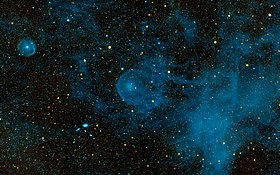| Observation data Epoch J2000 Equinox J2000 | |
|---|---|
| Constellation | Leo |
| Right ascension | 09h 47m 57.406s[1] |
| Declination | +13° 16′ 43.56″[1] |
| Apparent magnitude (V) | 14.5 (var.)[2] |
| Characteristics | |
| Spectral type | C9,5e[3] |
| Apparent magnitude (R) | 10.96[1] |
| Apparent magnitude (J) | 7.34[1] |
| Apparent magnitude (H) | 4.04[1] |
| Apparent magnitude (K) | 1.19[1] |
| Variable type | Mira[4] |
| Astrometry | |
| Proper motion (μ) | RA: 35±1 mas/yr Dec.: 12±1[5] mas/yr |
| Parallax (π) | 10.56 ± 2.02 mas[6] |
| Distance | approx. 310 ly (approx. 90 pc) |
| Details | |
| Mass | 0.7 - 0.9[5] M☉ |
| Radius | 560[7] R☉ |
| Luminosity | 8,500 (average), 11,850 (maximum)[7] L☉ |
| Temperature | 2,300[7] (1,915 - 2,105)[8] K |
| Other designations | |
| Database references | |
| SIMBAD | data |
CW Leonis or IRC +10216 is a variable carbon star that is embedded in a thick dust envelope. It was first discovered in 1969 by a group of astronomers led by Eric Becklin, based upon infrared observations made with the 62-inch Caltech Infrared Telescope at Mount Wilson Observatory. Its energy is emitted mostly at infrared wavelengths. At a wavelength of 5 μm, it was found to have the highest flux of any object outside the Solar System.[10]
- ^ a b c d e f Cite error: The named reference
2masswas invoked but never defined (see the help page). - ^ Cite error: The named reference
catalinawas invoked but never defined (see the help page). - ^ Cite error: The named reference
cohenwas invoked but never defined (see the help page). - ^ Cite error: The named reference
gcvswas invoked but never defined (see the help page). - ^ a b Cite error: The named reference
matthewswas invoked but never defined (see the help page). - ^ Cite error: The named reference
sozettiwas invoked but never defined (see the help page). - ^ a b c Cite error: The named reference
schmidtwas invoked but never defined (see the help page). - ^ Cite error: The named reference
bergeatwas invoked but never defined (see the help page). - ^ Cite error: The named reference
SIMBADwas invoked but never defined (see the help page). - ^ Cite error: The named reference
apj158_L133was invoked but never defined (see the help page).
